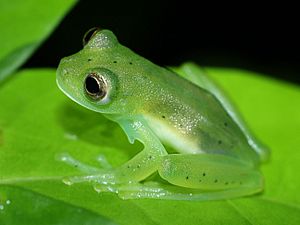Andes giant glass frog facts for kids
Quick facts for kids Andes giant glass frog |
|
|---|---|
 |
|
| Conservation status | |
| Scientific classification | |
| Synonyms | |
|
The Andes giant glass frog (Espadarana andina) is a special type of frog. It belongs to a group called Centrolenidae, known as "glass frogs" because some of them have skin so clear you can see their insides! This frog lives in the mountains of Colombia and Venezuela. You can find it in places like the Eastern Mountains of Colombia and the Mérida Andes in Venezuela.
These frogs love cloud forests and other mountain forests. They live near streams and lay their eggs on plants hanging over the water. Good news: this frog is not currently in danger of disappearing.
How They Reproduce
Scientists have studied how the Andes giant glass frog reproduces. They looked at where males choose to call for females. They also studied where females prefer to lay their eggs.
The studies found that these frogs don't change their favorite spots much. It doesn't matter if it's rainy or dry season. The time of day or the month of the year also doesn't seem to affect their choices. Interestingly, they often lay their eggs on a plant called Hedychium coronarium. This plant is not native to the area.
How They Grow
Young Andes giant glass frogs, called tadpoles, look a bit different from adults. They have spots and a brownish color on their skin. But just like the adult frogs, their skin is see-through. You can even see their chondrocranium, which is the cartilage part of their skull.
As the tadpole grows, its eyes and nostrils (nares) develop. At first, the nostrils are closer to the eyes than to the snout. But as the frog gets older, its nostrils move closer to its snout. Also, when they are very young, their eyesight isn't fully developed. As they mature, their eyesight gets much better. This means their eyes learn to see properly.
Tadpoles also have a hard, beak-like mouth part made of keratin. This beak disappears as they grow. Their tiny tooth-like structures, called denticles, change into small bumps called papillae. The fins that help tadpoles swim also change. They grow into legs as the tadpole turns into a frog.
See also
 In Spanish: Espadarana andina para niños
In Spanish: Espadarana andina para niños


